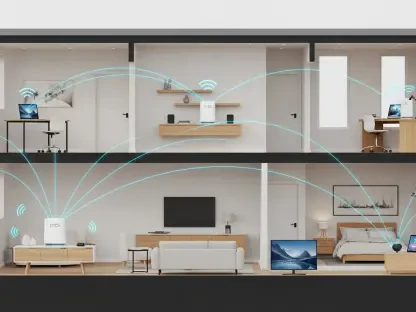Today, we’re thrilled to sit down with Vladislav Zaimov, a seasoned telecommunications specialist with deep expertise in enterprise telecommunications and risk management of vulnerable networks. With years of experience navigating the complexities of wireless technology and Radio Access Networks (RAN), Vladislav offers invaluable insights into the latest trends and dynamics shaping this critical industry. In this conversation, we’ll explore the state of the global RAN market in Q3 2025, unpack vendor performance across regions, and dive into emerging technologies like Open RAN. Let’s get started.
What can you tell us about the significance of the global RAN market reaching $8 billion in revenue during Q3 2025?
The $8 billion figure for Q3 2025 is a strong indicator of the RAN market’s resilience and growth trajectory. It reflects the total revenue from hardware and software components, excluding services, and underscores the ongoing demand for robust network infrastructure as 5G deployments expand worldwide. This milestone highlights how critical RAN technology is to supporting everything from mobile connectivity to enterprise solutions, especially as digital transformation accelerates across industries.
How does this revenue split between hardware and software, and what does that tell us about market trends?
While exact splits can vary, hardware still tends to dominate due to the need for physical infrastructure like base stations and antennas. However, software is gaining ground rapidly as virtualization and cloud-native solutions become more integral to RAN deployments. This shift signals a broader trend toward flexibility and scalability in networks, where software-defined approaches allow operators to adapt quickly to changing demands without heavy hardware investments.
What do you see as the primary drivers behind this impressive revenue figure for the third quarter of 2025?
Several factors are at play here. First, the global rollout of 5G continues to push demand for upgraded RAN infrastructure. Second, there’s a growing appetite for enhanced mobile broadband and low-latency applications, especially in urban areas. Additionally, government initiatives and private investments in digital connectivity, particularly in emerging markets, are fueling deployments. It’s a combination of technological need and strategic prioritization on a global scale.
Were there any unexpected findings or shifts in the Q3 2025 data compared to earlier periods?
One notable aspect is the sustained momentum outside China, which wasn’t always a given in prior quarters when certain regions faced economic or regulatory headwinds. The steady performance of key vendors across diverse geographies also stands out, showing that the market is maturing with more predictable growth patterns. That said, the slower uptake of some transformative technologies in specific regions was a bit of a surprise, pointing to adoption challenges that still need addressing.
Huawei, Ericsson, and Nokia lead the global RAN revenue rankings—what’s giving these giants their competitive advantage?
These companies have a combination of long-standing expertise, extensive R&D investments, and broad geographic reach. Huawei benefits from strong domestic support in China and aggressive pricing strategies. Ericsson and Nokia, on the other hand, excel in innovation and have built trust in markets prioritizing security and reliability, especially in Europe and North America. Their ability to deliver end-to-end solutions and adapt to local regulatory environments keeps them ahead of the pack.
Excluding China, Ericsson tops the list. What’s fueling their dominance in other parts of the world?
Ericsson’s strength outside China comes down to their focus on high-quality, secure solutions that resonate with operators in regions like North America and Europe, where data privacy and network reliability are paramount. They’ve also been quick to embrace trends like virtualization, which appeals to operators looking to future-proof their networks. Strong partnerships with local carriers and a reputation for consistent performance further cement their position.
How do smaller players like ZTE and Samsung stack up against the top three in terms of market presence and innovation?
ZTE and Samsung are carving out significant niches, though they’re not yet at the scale of the top three. ZTE has a strong foothold in Asia, leveraging cost-competitive solutions, while Samsung is making waves with its focus on 5G innovation, particularly in markets like North America. Both are pushing hard on R&D, but they often lack the global reach and diversified portfolios of the leaders, which limits their overall market share for now.
Are there any up-and-coming vendors that could disrupt the current rankings in the coming years?
Absolutely, there are a few emerging players to watch, especially those focusing on niche areas like Open RAN and virtualization. Smaller firms with specialized offerings or regional strengths could gain traction as operators seek multi-vendor environments to avoid lock-in with the big names. While it’s too early to name specific disruptors, the push for open architectures is creating opportunities for new entrants to challenge the status quo.
In North America, Ericsson, Nokia, and Samsung dominate. What factors are contributing to their success in this region?
North America’s market is heavily driven by the need for cutting-edge 5G networks, and these vendors have tailored their offerings accordingly. Ericsson and Nokia bring proven reliability and strong local partnerships with major carriers. Samsung, meanwhile, has gained ground with innovative 5G solutions and competitive pricing. Additionally, regional policies favoring security and domestic innovation tend to align with the strengths of these companies.
How does the competitive landscape differ in Asia and Oceania, where Huawei and ZTE lead the pack?
In Asia and Oceania, Huawei and ZTE benefit from strong regional ties, particularly in China, where domestic support and scale give them an edge. The region’s diverse needs—from massive urban deployments to rural connectivity—play to their ability to offer cost-effective, high-volume solutions. Nokia still holds a spot in the top tier due to its global expertise, but the local advantage of Huawei and ZTE is a significant differentiator here.
Europe shows Ericsson and Nokia at the forefront, with Huawei in third. What regional dynamics are shaping this order?
Europe’s landscape is heavily influenced by stringent regulations around network security and data protection, which favor Ericsson and Nokia due to their established trust and compliance with local standards. Huawei’s presence, while notable, is tempered by geopolitical concerns and restrictions in several countries. There’s also a strong push for innovation in 5G and beyond, which aligns with the R&D strengths of the top two.
Huawei and Ericsson lead in the Middle East, Africa, Latin America, and the Caribbean. What’s driving their success in these regions?
In these regions, the focus is often on rapid deployment and cost efficiency, areas where Huawei excels with its scalable, affordable solutions. Ericsson complements this with high-quality offerings and a reputation for reliability, which appeals to operators in markets with growing connectivity needs. Infrastructure gaps and government-backed digital initiatives also create fertile ground for these vendors to dominate.
Looking ahead, are there any regions where you anticipate major changes in vendor rankings over the next couple of years?
I’d keep an eye on regions like Latin America and parts of Africa, where economic growth and digital inclusion efforts could attract new players or shift existing dynamics. As policies evolve and investment pours in, vendors with flexible, cost-effective solutions could climb the ranks. Additionally, North America might see shifts if emerging technologies like Open RAN gain broader traction, potentially leveling the playing field.
There’s positive momentum in the RAN market outside China—what’s behind this encouraging growth?
Outside China, growth is being driven by sustained 5G rollouts, especially in developed markets where operators are upgrading to meet consumer and enterprise demands. There’s also a push for network densification in urban areas and expanded coverage in rural ones. Government funding and private sector investments in digital infrastructure are further boosting momentum, creating a virtuous cycle of demand and deployment.
Analysts predict low single-digit growth for the RAN market outside China this year. What challenges or opportunities do you see shaping this outlook?
On the opportunity side, the continued push for 5G and emerging use cases like IoT and smart cities are key growth drivers. However, challenges include supply chain constraints, regulatory hurdles in some regions, and the high cost of deployment in less developed areas. Balancing innovation with affordability will be critical for vendors to capitalize on this modest growth trajectory.
How does the growth trajectory in China compare to the rest of the world, and what accounts for any differences?
China’s growth often outpaces other regions due to its massive scale, government support for tech advancement, and rapid urbanization. The rest of the world varies widely—some markets are catching up with 5G, while others lag due to economic or infrastructural barriers. China’s centralized approach and domestic vendor dominance create a faster, more unified deployment pace compared to the fragmented, regulation-heavy environments elsewhere.
Can you elaborate on the role of Open RAN and virtualization in transforming the RAN landscape, particularly in regions like Japan?
Open RAN and virtualization, often referred to together as open vRAN, are game-changers because they break down traditional vendor lock-in by disaggregating hardware and software functions and using open interfaces. Japan stands out as a leader—think of networks like Rakuten Mobile, which showcase the world’s largest open vRAN deployment. This approach allows for multi-vendor setups and flexibility, reducing costs and speeding up innovation. In Japan, early adopters have set a global benchmark, though progress elsewhere in Asia-Pacific remains slower with mostly pilot projects.
What is your forecast for the future of Open RAN adoption globally over the next few years?
I’m cautiously optimistic about Open RAN’s future. While it’s transformative, full-scale adoption will take time due to technical complexities and the need for ecosystem maturity. Japan will likely remain a leader, but I expect gradual progress in markets like North America and Europe as operators gain confidence in multi-vendor setups. The real tipping point will come when cost savings and performance reliability are proven at scale—probably within the next three to five years, assuming collaboration between vendors and operators accelerates.









